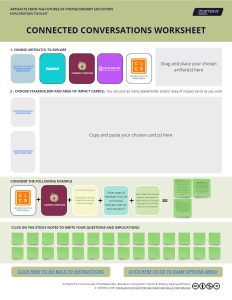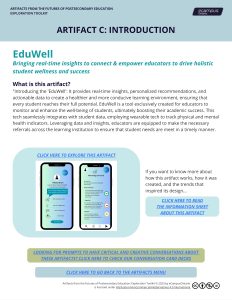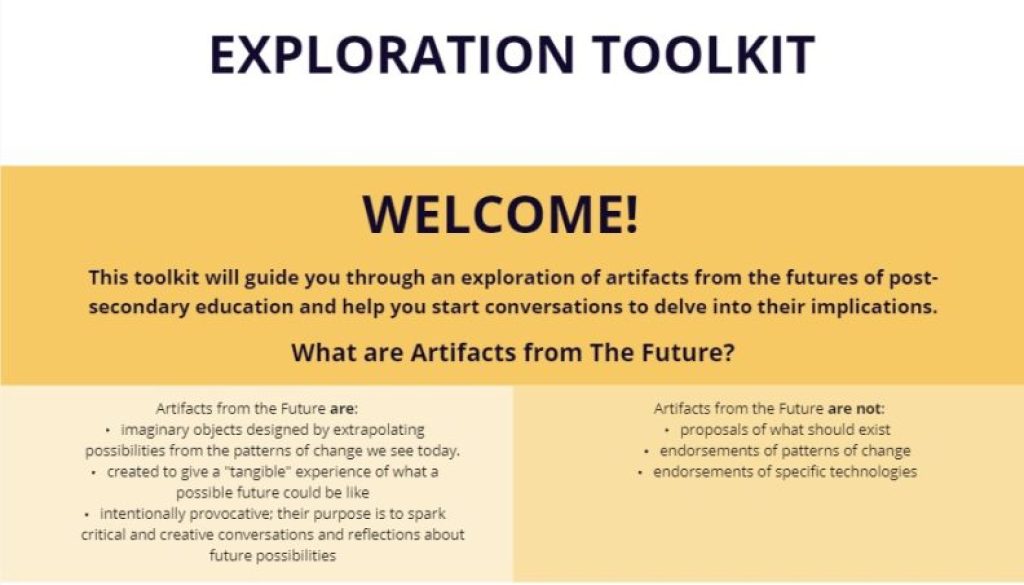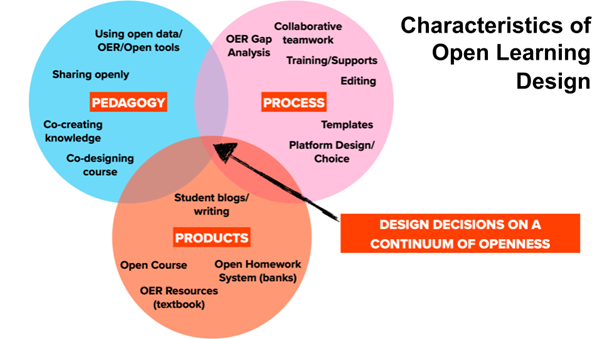Artifacts from the Futures of Higher Education
Authors:
- Elisa Arnold, eCampusOntario
- Laura Viselli, eCampusOntario
Thinking about the long-term future can be challenging. It can be too abstract or ambiguous. The possibilities of what may happen can be just as exciting as they are overwhelming, and navigating between those extremes is complex.
Human beings have the capacity for futures thinking. We have the imagination and creativity to do so, and it is likely that we are already doing it in some form. It is often our own barriers, like our preconceived notions of the future, societal structures, or our own experiences, that prevent us from engaging in futures thinking. As Maree Conway remarks, “using our imaginations to explore possible futures is something we can all do, as long as we accept that the ‘unimaginable’ is a construct of our times” (113).
Engaging in long-term thinking exercises is essential because the choices we make today will shape the possible futures. In foresight practice, we refer to the future in the plural. As we cannot predict the future, no definite image or vision exists. Thus, the future will always be an infinite range of possible outcomes rather than a single destination. This small change in language has the profound ability to change the way we think about the future. Our feelings can change from overwhelmed to empowered. There are many possible futures: let’s make decisions today to build a future we can be proud of. But how?
At a time of accelerated, complex, and uncertain change, making sense of ambiguity and understanding a broad spectrum of long-term possibilities is a critical skill to inform agile transformation strategies. For such purposes, strategic foresight is a highly relevant practice. Strategic foresight is a research-driven exploration of possible futures by identifying evidence of change in the present and extrapolating long-term implications for transformation.
Since 2021, eCampus Ontario’s Research and Foresight team has explored trends and their implications for postsecondary education in our Foresight Reports. Foresight reports are tools that support the navigation of uncertain and complex futures and are used to engage in strategic action. The Research and Foresight team built Artifacts from the Futures of Postsecondary Education based on the identified trends to further the understanding, use, and impact of these reports.
Designing Artifacts from the Futures
Artifacts from the future are fictional objects created to give a “tangible” experience of a possible future. They are intentionally provocative and intended to spark critical and creative conversations and reflections about future possibilities. They are imaginary educational technologies that, in 2033, would be as mainstream as the Learning Management System (LMS) is today.
It is important to describe what artifacts are not. As Smith and Ashby describe, they “are not an attempt to demonstrate a means of resolving problems that exist within the larger world…in the futuring context, we should consider ‘the object as the entry point, not as the terminal point” (151). Artifacts are a starting point for conversation, not recommendations or endorsements.
Increasing the utility of our foresight reports and building an immersive experience for our audience drove this work. When we took our reports and research to post-secondary institutions at conferences, workshops, and webinars, our audiences raved about the experience. They wanted more; they liked the research but wanted a way to experience our work in new dimensions. Many exclaimed they wanted ‘practical implications’ or to ‘see’ how our research would manifest at their institutions or within their roles.
While reinforcing that we do not predict the future, but use the future as a place for exploration, we realized our community would benefit from multiple entry points to explore the futures of higher education.
Following this recognition, six members of the Research and Foresight team convened for this project. Each artifact had its own lead designer who spearheaded the design and prototyping. The methodologies used by the design team included horizon scanning, application of foresight tools and frameworks, and critical conversations to identify problems and ethical concerns about the futures of higher education. The design process also included ongoing, guided self-reflections, including an evaluation of positionality.
This project was also guided by ethical principles that are co-created and continually validated by the research team. These principles are:
- we are intersectional people first.
- we are learners and educators.
- we understand there are multiple futures.
- we engage in participatory action.
We have given additional consideration to ethical principles when using foresight methods as these methods have historically been instruments of military, colonial and corporate power. Our approach when applying foresight methods while designing these artifacts, reflects the:
- belief we can create the future
- the intention to de-colonize
- the intention to improve equity and fairness.
In combination, these principles provided the framework the team used to inform the design process as well as the desired output.
Launching Artifacts from the Futures
The artifacts were unveiled for the first time at eCampusOntario’s annual Technology and Education Seminar and Showcase (TESS) conference. The showcase produced incredible reactions from the crowd. The conversation veered from learner-educator relationship dynamics to privacy to the evolving role of support staff and administrators in higher education. We saw firsthand the critical role our artifacts played that they, as Smith and Ashby point out, “do the heavy lifting of carrying the context and complexity of a future” (151).
The complexity is conveyed through the design of the artifacts. They are intentionally provocative, embedding ethical struggles and debate within their fictional future to spark critical and conversations and reflections about their long-term implications. Participants were supporting in exploring ethics related to emerging technology through deconstructing and questioning the speculative artifact.
The showcase reinforced that we needed to get our Artifacts into more hands. Through the discussion following the showcase, we also learned that providing a guided approach to engaging with the Artifacts could further their impact. As such, we created the Artifacts from the Futures of Postsecondary Education Exploration Toolkit.
The toolkit includes four (4) artifacts and three (3) card deck games designed to spark critical and creative conversations to explore a broad spectrum of futures of post-secondary education. The card decks allow players to explore the perspectives of multiple stakeholder groups and different areas of impact such as curriculum development, assessment, credentials, and more.

Toolkit Connected Conversations Worksheet

Artifact C Sample Page from Toolkit
At eCampusOntario, we believe that foresight is a capacity to be learned and shared by individuals, teams, and organizations to build resilient leaders and institutions and to support impactful projects. The toolkit has been released as an Open Education Resource on eCampusOntario’s Open Library for those who wish to explore potential futures of higher education.
Access the Artifacts from the Futures of Postsecondary Education Exploration Toolkit now:
References
Conway, Maree. Foresight Infused Strategy. Thinking Futures, 2019.
Smith, Scott, and Ashby, Madeline. How to Future: Leading and Sense-Making in an Age of Hyperchange. Kogan Page Inspire, 2020.



